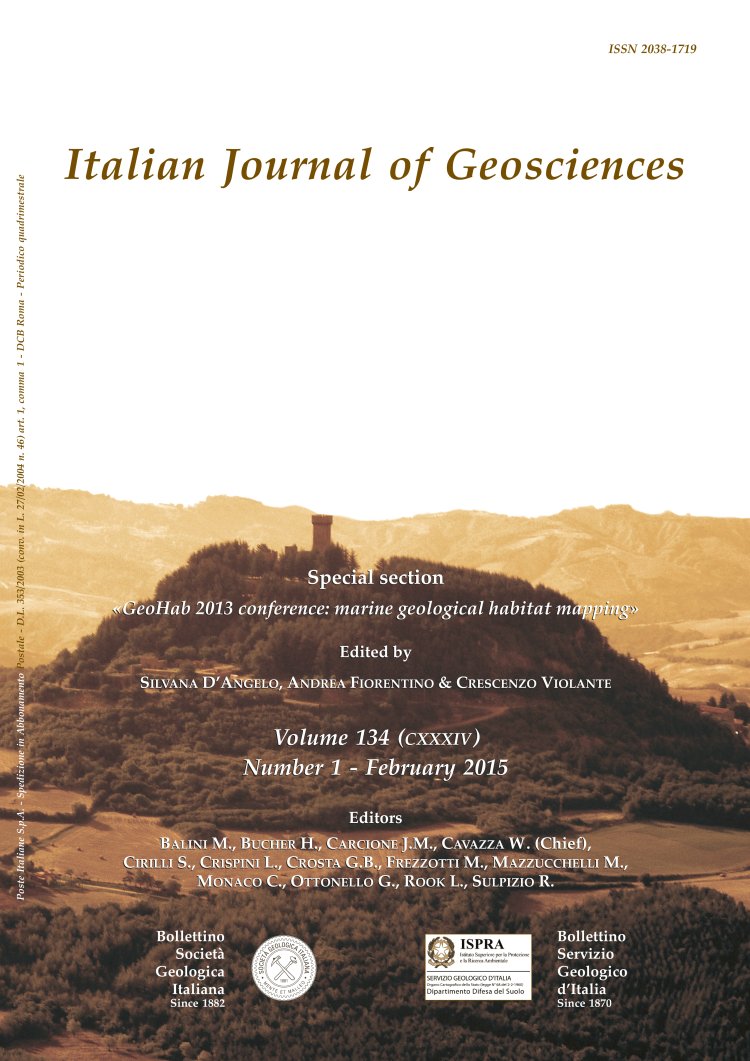
Habitat mapping of cold seeps associated with authigenic mineralization (Paola Ridge, southern Tyrrhenian Sea): combining seafloor backscatter with biogeochemistry signals
Marzia Rovere (*), Heba Rashed (**), Elena Pecchioni (**), Alessandra Mercorella (*), Alessandro Ceregato (*), Elisa Leidi (*), Fabiano Gamberi (*), Orlando Vaselli (**) & (***)
(*) Istituto di Scienze Marine, Consiglio Nazionale delle Ricerche, Via P. Gobetti, 101 - 40129 Bologna, Italy.
(**) Dipartimento di Scienze della Terra, Università di Firenze, Via La Pira, 4 - 50121 Firenze, Italy.
(***) Istituto di Geoscienze e Georisorse, Consiglio Nazionale delle Ricerche, Via La Pira, 4 - 50121 Firenze, Italy.
Corresponding author: Marzia Rovere m.rovere@ismar.cnr.it, Istituto di Scienze Marine Via P. Gobetti, 101 - 40129 Bologna, Italy.
Fax +39 051 6398940, Telephone +39 051 6398861.
Volume: 134 (2015) f.1
Pages: 23-31
Abstract
Mineralogical, petrographic and stable isotope analyses were carried out on sediment and rock samples collected from a deep-sea cold seep province in the Paola Ridge (southeastern Tyrrhenian Sea). The results, coupled with the interpretation of the seafloor backscatter, constrained both the biogeochemical zonation and the spatial distribution of the cold seep habitats in the area. These have proved to change in depth in a range of few meters and laterally
within narrow zones. The mud volcanoes, characterized by a high backscatter signature, are the site of vigorous gas venting and, in the subsurface, show a rapid transition from the oxic sea water interface toward the methane-sulfate transition zone in the sediments. Intermediate backscatter typifies areas where free venting is hampered by the presence of mudflows at the seafloor. These conditions favor: i) the oxidation of sulfides near the seafloor, ii) the precipitation of siderites a few meters below the seafloor and iii) the formation of sulfides deeper in the sub-seafloor. Faults are likely candidates to act as conduits for sulfates and metal oxides that juxtapose different redox environments. Siderites precipitated in the fast and low venting sites showed enrichment in δ13C and δ18O, which are compatible with their precipitation in the methanogenic zone. The heavy-oxygen isotopic compositions of the siderites are possibly related to the dissociation of gas hydrates, which have not been mapped so far by seismic data in the study area. Mud diapirism is characterized by low backscatter seafloor, large fields of pockmarks and is dissected by
normal faults. In coincidence with the normal faults, authigenic calcites and aragonites are present at or very close to the seafloor. They have the typical isotopic signature indicating formation during sulfate-dependent microbially-mediated anaerobic oxidation of methane.
They are associated with Lucinoma borealis, the youngest being dated 640-440 BP. This suggests that the seepage activity in the mud diapirs was likely clogged by either carbonates or activity of the faults only very recently.
Keywords
Get Full Text